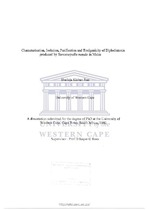Characterisation, Isolation, Purification and Toxigenicity ofDiplodiatoxin produced by Stenocarpella maydis in Maize
| dc.contributor.advisor | Rees, D Jasper G | |
| dc.contributor.author | Rao, Shailaja Kishan | |
| dc.date.accessioned | 2021-05-11T17:16:26Z | |
| dc.date.available | 2021-05-11T17:16:26Z | |
| dc.date.issued | 2002 | |
| dc.identifier.uri | http://hdl.handle.net/11394/8258 | |
| dc.description | Philosophiae Doctor - PhD | en_US |
| dc.description.abstract | Mycotoxins attract worldwide attention because of the significant economic losses associated with their impact on human health, animal productivity, domestic and international trade. Over 300 mycotoxins have been discovered, of which a few are of serious concern (Smith and Moss 1985; Rheeder et al., 1994). Exposure to these mycotoxins can produce both acute and chronic effects ranging from death to effects upon the central nervous, cardiovascular, pulmonary systems and upon the alimentary tract. Mycotoxins may be carcinogenic, mutagenic, teratogenic and immunosuppressive (Ferrante et al., 2002). Mycotoxins are currently considered as a major problem in developing countries (Miller, 1994). | en_US |
| dc.language.iso | en | en_US |
| dc.publisher | University of the Western Cape | en_US |
| dc.subject | Protein | en_US |
| dc.subject | Mycotoxins | en_US |
| dc.subject | Maize | en_US |
| dc.title | Characterisation, Isolation, Purification and Toxigenicity ofDiplodiatoxin produced by Stenocarpella maydis in Maize | en_US |
| dc.rights.holder | University of the Western Cape | en_US |

